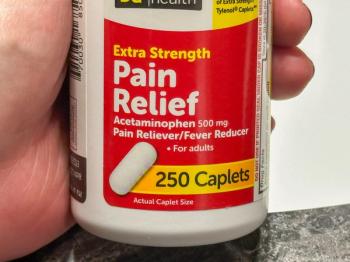
- April 2023
- Volume 89
- Issue 4
OTC Cases: Bone Health
Case 1: Calcium
Q: JC is a woman aged 72 years who is looking for a calcium supplement recommended by her primary care physician for osteoporosis. JC just started taking alendronate because she is at high risk for fractures. She is otherwise healthy with no medical conditions. JC has never taken a calcium supplement and is unsure how much she should take each day. What should the pharmacist recommend?
A: Because JC is postmenopausal and has osteoporosis, she should take a daily calcium supplement with cholecalciferol (vitamin D) to reduce the risk of fractures. It is recommended that women older than 50 years with osteoporosis take a total of 1200 mg of calcium carbonate per day, which includes dietary and supplemented calcium.1 Calcium carbonate is best absorbed when the dose is between 500 and 600 mg, so JC should divide the total into 2 dosages per day.2,3 The pharmacist should assess how much dietary calcium she is taking before recommending a dosage. If JC has no dietary calcium intake, she can take 600 mg of calcium carbonate twice daily for maximal absorption to reduce the risk of fractures.
Case 2: Increasing Vitamin D Levels
Q: LK is a woman aged 66 years with a history of chronic kidney disease, hypertension, hyperlipidemia, and osteoporosis. Her provider recommended that she takes an OTC vitamin D supplement, because her vitamin D level is low. LK already takes a calcium supplement but wants to know about how vitamin D can help manage osteoporosis. What should the pharmacist advise?
A: The pharmacist should tell LK that vitamin D helps increase calcium absorption in the body, which helps decrease the risk of fractures with osteoporosis. For patients older than 50 years, it is recommended that they receive between 800 and 1000 units of vitamin D daily, so that is what the pharmacist should recommend.1,3 Vitamin D levels can also be increased through sun exposure. The pharmacist can advise LK to increase sun exposure safely by using sunscreen with a sun protection factor of at least 15. Additionally, the pharmacist can provide education on food sources high in vitamin D, including fortified cereals, milk, and fatty fish such as salmon, trout, and tuna.4
Case 3: Proton Pump Inhibitors
Q: KP is a woman aged 59 years with a history of gastroesophageal reflux disease (GERD), hyperlipidemia, and type 2 diabetes. She takes atorvastatin (Lipitor), metformin, and pantoprazole (Protonix). KP recently read an article stating that proton pump inhibitors (PPIs) can cause bone loss and wants to know whether this is true. She is concerned because her mother has osteoporosis and she does not want to develop the condition. How should the pharmacist respond?
A: There is evidence demonstrating a reduction in bone mass density among patients who take PPIs.5 Some study results have shown a significant increase in fractures among patients who take PPIs. The risk is higher in patients who require multiple daily dosing or take PPIs for a year or more.6-8 In 2020, the results of a cohort study by Wei et al showed a 27% increased risk of hip fractures in patients 50 years and older who recently started taking a PPI compared with histamine type 2 receptor antagonists.9 This potential relationship may occur, because some calcium requires an acidic environment for absorption, and PPIs reduce acidity in the stomach.10 In patients with lower stomach acidity, calcium citrate would be the recommended form of calcium. Because KP is older than 50 years, she should take 1200 mg of calcium citrate divided into 2 doses.3 Ideally, she should take pantoprazole for the shortest duration possible to manage the GERD and decrease the risk of bone loss and fractures.
Case 4: Osteoarthritis
Q: JF is a man aged 62 years who has had pain in his knees for the past 2 days and is looking for an OTC product for bone pain. He also has stiffness in his knees, which improves once he starts moving. JF says he has had this pain in the past but usually does not take anything. He walks for exercise 4 times a week, which helps reduce the pain. JF has a history of migraines and osteoarthritis but has not used OTC medications to relieve the pain. What should the pharmacist recommend?
A: The pharmacist should tell JF that the pain may be related to his osteoarthritis. The 2019 American College of Rheumatology/Arthritis Foundation Guideline for the Management of Osteoarthritis of the Hand, Hip, and Knee strongly recommends topical and oral nonsteroidal anti-inflammatory drugs (NSAIDs) as first-line therapy for osteoarthritis management in the knees. Topical NSAIDs are preferred over oral NSAIDs because they have less systemic absorption.11 Diclofenac is an OTC topical NSAID that can be used to manage osteoarthritis. There are multiple OTC NSAID products, such as ibuprofen and naproxen. It is important to assess cardiovascular and renal disease, as well as any history of gastrointestinal issues prior to initiation of oral NSAIDs.12
References
- Eastell R, Rosen CJ, Black DM, Cheung AM, Murad MH, Shoback D. Pharmacological management of osteoporosis in postmenopausal women: an Endocrine Society* clinical practice guideline. J Clin Endocrinol Metab. 2019;104(5):1595-1622. doi:10.1210/jc.2019-00221
- Camacho PM, Petak SM, Binkley N, et al. American Association of Clinical Endocrinologists/American College of Endocrinology clinical practice guidelines for the diagnosis and treatment of postmenopausal osteoporosis—2020 update. Endocr Pract. 2020;26(suppl 1):1-46. doi:10.4158/GL-2020-0524SUPPL
- Calcium and vitamin D. Bone Health & Osteoporosis Foundation. Updated January 11, 2023. Accessed February 24, 2023.
https://www.bonehealthandosteoporosis.org/patients/treatment/calciumvitamin-d/ - Vitamin D fact sheet for consumers. National Institutes of Health Office of Dietary Supplements. Updated November 8, 2022. Accessed February 2, 2023.
https://ods.od.nih.gov/factsheets/Vitamind-Consumer/ - Aleraij S, Alhowti S, Ferwana M, Abdulmajeed I. Effect of proton pump inhibitors on bone mineral density: a systematic review and meta-analysis of observational studies. Bone Rep. 2020;13:100732. doi:10.1016/j.bonr.2020.100732
- Vestergaard P, Rejnmark L, Mosekilde L. Proton pump inhibitors, histamine H2 receptor antagonists, and other antacid medications and the risk of fracture. Calcif Tissue Int. 2006;79(2):76-83. doi:10.1007/s00223-006-0021-7
- Gray SL, LaCroix AZ, Larson J, et al. Proton pump inhibitor use, hip fracture, and change in bone mineral density in postmenopausal women: results from the Women’s Health Initiative. Arch Intern Med. 2010;170(9):765-771. doi:10.1001/archinternmed.2010.94
- Paik JM, Rosen HN, Gordon CM, Curhan GC. Proton pump inhibitor use, H2-receptor antagonist use, and risk of incident clinical vertebral fracture in women. Calcif Tissue Int. 2018;103(4):380-387. doi:10.1007/s00223-018-0432-2
- Wei J, Chan AT, Zeng C, et al. Association between proton pump inhibitors use and risk of hip fracture: a general population-based cohort study. Bone. 2020;139:115502. doi:10.1016/j.bone.2020.115502
- Lespessailles E, Toumi H. Proton pump inhibitors and bone health: an update narrative review. Int J Mol Sci. 2022;23(18):10733. doi:10.3390/ijms231810733
- Kolasinski SL, Neogi T, Hochberg MC, et al. 2019 American College of Rheumatology/Arthritis Foundation Guideline for the Management of Osteoarthritis of the Hand, Hip, and Knee. Arthritis Care Res (Hoboken). 2020;72(2):149-162. doi:10.1002/acr.24131
- Selecting the right OTC pain medication. U.S. Pharmacist. May 22, 2012. Accessed February 28, 2023.
https://www.uspharmacist.com/article/selecting-the-right-otc-pain-medication
About the Authors
Deanna Fox, PharmD, is a PGY1 pharmacy resident at Atlantic Health System in Morristown, New Jersey.
Nicole Rudawsky, PharmD, BCPS, is a clinical assistant professor of pharmacy practice and administration at the Ernest Mario School of Pharmacy at Rutgers, The State University of New Jersey in Piscataway.
Rupal Patel Mansukhani, PharmD, FAPhA, CTTS, is a clinical associate professor of pharmacy practice and administration at the Ernest Mario School of Pharmacy at Rutgers, The State University of New Jersey in Piscataway, and a transitions-of-care clinical pharmacist at Morristown Medical Center.
Articles in this issue
over 2 years ago
Pharmacists Are Vital to Transitions of Careover 2 years ago
Pharmacy Times Interactive Case Studies: April 2023over 2 years ago
Pharmacists' Pet Peeves: April 2023over 2 years ago
Generic Product News: April 2023over 2 years ago
Tzield From Provention Bio, Incover 2 years ago
OTC Product News: April 2023over 2 years ago
Rx Product News: April 2023over 2 years ago
Recent Guidelines Recommend SMART Treatment for Asthmaalmost 3 years ago
RxPass Offers Access to Low-cost Drugs, but Not for Medicare EnrolleesNewsletter
Stay informed on drug updates, treatment guidelines, and pharmacy practice trends—subscribe to Pharmacy Times for weekly clinical insights.














































































































































































































